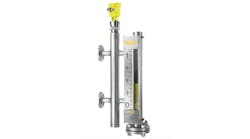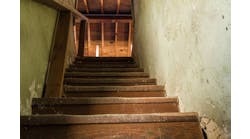Non-contacting radar isn’t the only technology replacing old, mechanical level measurement systems. Another type of radar, guided wave radar (GWR) has gained usage over the last few decades, particularly for difficult applications where there may be two or more liquids mixing with one another. Just as non-contacting radar has done, GWR is opening new possibilities for industries beyond traditional level measurement customers.
“The guided wave radar opens more possibilities when there’s a layer where the actual interface between the two liquids is not really defined,” says David Trinh, senior product manager for Emerson.
Trinh says that while radar antennas (non-contacting) are a very powerful way to measure liquid levels, GWR has the advantage of having a probe which has contact with the liquid. “It gives you better signal and the ability to measure things like interfaces between two different liquids,” he continues.
Oil and gas process tanks remain a core application for GWR because inevitably they have oil and water in the same tank. With a guided wave radar probe, users can measure both the oil and the water whereas a non-contacting radar would only measure the level of the uppermost liquid. Steam boilers are another common application for GWR where vapors can disrupt the microwaves and the presence of a probe can alleviate such disruptions. Distillation columns where chemicals are boiling and are separated in levels in a tower are a related application containing steam where in each level, users would have a guided wave radar measuring the level of a particular fraction of the chemical.
In addition, GWR is useful in “dry” applications such as blowdown drums. “In the process industries, you don’t want adverse effects. You could have a process running along, and then you have a drum where if suddenly something would happen in the reactor, the liquid gets sent into this drum,” Trinh explains. “That’s when you need a system which can quickly detect that there’s liquid in the blowdown drum. This liquid can be a mix of different process fluids with rapidly changing density and level. Guided wave radar is a great technology for it. It’s just a bit more responsive and can handle the rapidly changing conditions better than antenna-based radars. Certainly, compared to non-contacting radar technologies, the guided wave radar is a good fit for that type of application.”
“We’ve put a lot of engineering effort into making sure our radar portfolio is capable of a lot of applications,” he continues. “We’re getting into tough applications where you’ve got very high temperatures. Those types of applications can be really challenging for more traditional technologies. Emerson has invested significantly into signal processing with industry leading Direct Switch Technology built in to GWR instruments allowing for faster, more responsive units.”
Aside from the probes used in traditional process industry products, Emerson has designed metal probes, which carry the microwaves. They have a plastic coating such as PTFE or PFA plastic. “Those are more for pharmaceutical industries or measuring food,” he says.
Specialization of the probes
Emerson has invested in creating a wide portfolio of guided wave radar products. Its main technology offering is the Rosemount 5300 guided wave radar.
Guided wave radar is not made of one type of probe. Emerson has flexible probes for measuring solids. It also has rigid probes. In addition, it has special, high-performance products such as its large coaxial probe.
“It’s a probe inside a probe. It’s two probes in one,” Trinh explains. “We use the difference between those to be able to really measure thin interfaces, when a liquid is on top of another liquid. That’s a challenge, and that was overcome with the creation of guided wave radar.
“But when the top-level liquid gets to be a small thickness in the range of less than an inch, then the signals tend to get lost,” he continues. “With the kind of large coaxial probe, we get the good signal-to-noise ratios and can really define these very thin interfaces.”
If that isn’t specialized enough, Emerson also has a Dynamic Vapor Compensation probe, which is made for boilers. “Boilers are particularly challenging for any type of measurement, any type of radar measurement because the liquid’s bubbling away. So, if you visualize a boiling saucepan of water, measuring the level on that is actually very difficult because the level’s not always constant,” Trinh explains. Above the liquid is typically gas, the steam that’s coming off the boiling liquid. It also disturbs a radar measurement. “But we have special probes, like the Rosemount 5300, with specially mounted metal reflectors and custom designed software algorithms to compensate for the disturbances,” Trinh says.
Enhanced with wireless capabilities
The Rosemount 3308A Transmitter is a sibling product to the Rosemount 5300 incorporating wireless technology with GWR probes. “We are the only provider with a native built-in wireless guided wave radar,” Trinh says.
Wireless capabilities open new applications for Emerson, particularly in regions where there might be a very isolated tank. “If you think an oil well in the middle of the desert and just pumping out oil from that well, and you have to put it into a tank, how do you measure that level?” Trinh asks. “You need to have a gauge, but you don’t want to have a gauge which is maintenance-intensive because it’s in the middle of the desert. Our Rosemount 3308A Wireless Level Transmitter let’s you put the gauge onto the storage tank, and it’s got a battery. It sends the signal to a wireless gateway.”
That means the oil and gas producer doesn’t need to run power wires or signal wires from a control station up the tank. “You just have the unit itself, and it’s self-contained,” Trinh says. “It sends the signal wirelessly to a gateway.”




